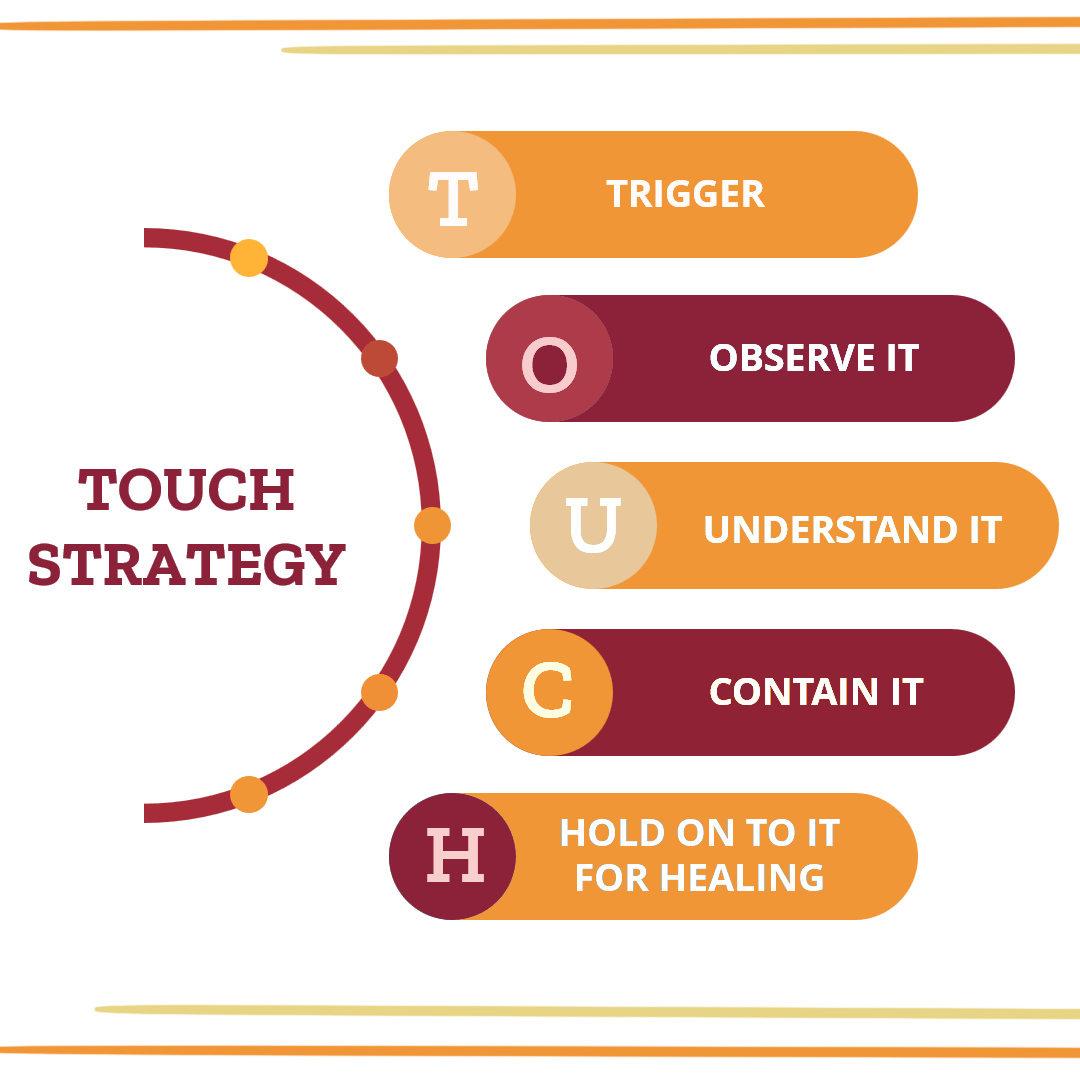
The TOUCH Technique as a Robust Mindfulness Practice
As trauma therapists, we understand that when we’re “triggered” by present situations that are similar to what we’ve been through before, the most important thing is to know that we’re triggered. We all know what it’s like to be “in it” rather than observing our reactions. To use a common metaphor, it’s the difference between being bashed against the rocks in a turbulent river versus observing the current from the shore. I don’t know about you but being in the water can be a really rough ride. I know because I have the bruises to prove it!
How Do We Remind Ourselves to Stay on the Shore?
So, how do we stay on the shore of the Observer Self? It’s called the TOUCH Technique. It’s a self-soothing and self-regulating strategy developed by Deany Laliotis that helps our clients identify when they’re being triggered in their lives, and to learn to shift from overreacting to observing their reaction, which helps them shift out of that painful, trauma-informed state. It’s a simple and effective way to help our clients be mindful of their emotional triggers to daily life challenges that can throw them off course. It can also be prescribed in between sessions when the client continues to process whether the session is complete or incomplete: “You may notice some additional feelings, thoughts, insights, memories, or dreams. If so, just notice - and use your TOUCH Technique.”
But let’s pause and really consider this strategy of literally touching into our experience. It is a transformative way of holding experience and strengthening our Observer Self. Remember, being able to observe one’s emotional experience is one of the readiness factors for reprocessing, right?
T for Trigger- This means pausing and taking a step back to recognize you are triggered. The past has become present, even if we don’t know what that association is. What we do know is that our reactions are out of proportion to the current context. This knowing helps us shift our experience and our relationship to it.
O for Observe- This wonderful magical ability allows us to take a step back. When we can do that, it helps us know we are not our experience. Instead, we are having one. And, when we know we are having an experience, by definition, it changes it. We are greater than what is happening, and noticing it allows for that moment-to-moment awareness. It’s comparable to the dual attention in reprocessing that allows our clients to tolerate in the moment what they couldn’t at the time these painful events occurred.
U for Understand it- Implicit in this is curiosity. Can we be curious about what that past-present connection is that threw us into the river? If we can make that implicit connection explicit, we develop a deeper knowing of ourselves. It also gets on the docket for reprocessing, so it doesn’t have to happen again in the same way.
C for Contain it- Just by noting it as a trigger is containing the experience. As Dan Siegel says, “name it to tame it.” This reminds us that we have agency and that nothing is happening “to” us. We can also invite our clients to put it away in an imaginary container of their choosing.
H for Hold on to it for Healing- We instruct our clients to bring it to session and to explore their readiness to address the root causes of their triggers. Once the decision is made based on a mutual understanding of the associations and the client’s readiness to “go there," we proceed with reprocessing the memory.
Developing a Strong Observer Self is a Life Saver
Many of you are familiar with meditation or mindfulness practices where we notice thoughts using the RAIN (Recognize, Allow, Investigate and Non-identify) acronym created by Michele McDonald, which serves a similar purpose. How about taking a few minutes with our clients to help them embody the practice of touching into their experience in this transformative way using the TOUCH Technique?
Approach and teach the TOUCH Technique in a powerful way to help clients develop greater agency to get to the shore and out of the turbulent emotional waters they find themselves in. I love it and they love it, too! We can help them discover that they can do this for themselves and empower them to make better choices for themselves than the choices that were made for them. We walk them through it as a future rehearsal by asking them to, “Notice that you can manage your experience the next time you get triggered by using TOUCH.” When the past becomes present, we can, with mindfulness, touch into the experience, observe it, understand it, and put it where it belongs.
